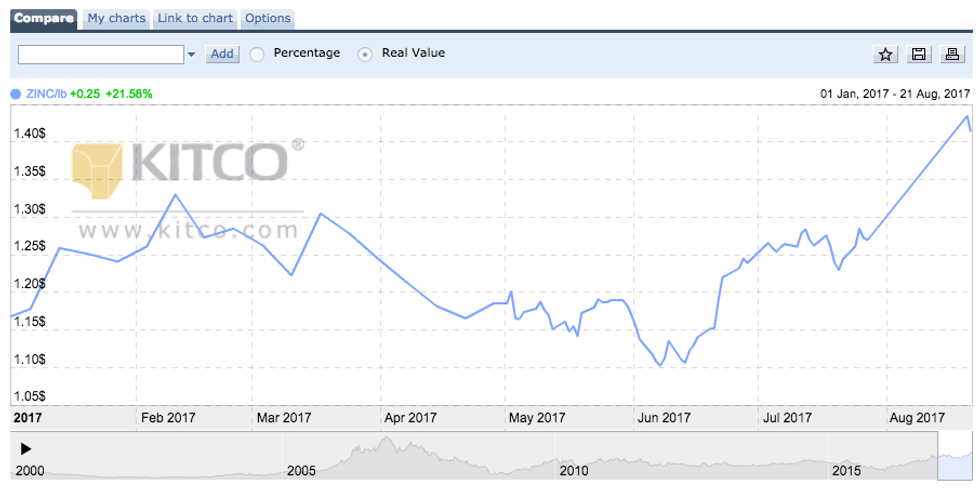- AustraliaNorth AmericaWorld
Investing News NetworkYour trusted source for investing success
- Lithium Outlook
- Oil and Gas Outlook
- Gold Outlook Report
- Uranium Outlook
- Rare Earths Outlook
- All Outlook Reports
- Top Generative AI Stocks
- Top EV Stocks
- Biggest AI Companies
- Biggest Blockchain Stocks
- Biggest Cryptocurrency-mining Stocks
- Biggest Cybersecurity Companies
- Biggest Robotics Companies
- Biggest Social Media Companies
- Biggest Technology ETFs
- Artificial Intellgience ETFs
- Robotics ETFs
- Canadian Cryptocurrency ETFs
- Artificial Intelligence Outlook
- EV Outlook
- Cleantech Outlook
- Crypto Outlook
- Tech Outlook
- All Market Outlook Reports
- Cannabis Weekly Round-Up
- Top Alzheimer's Treatment Stocks
- Top Biotech Stocks
- Top Plant-based Food Stocks
- Biggest Cannabis Stocks
- Biggest Pharma Stocks
- Longevity Stocks to Watch
- Psychedelics Stocks to Watch
- Top Cobalt Stocks
- Small Biotech ETFs to Watch
- Top Life Science ETFs
- Biggest Pharmaceutical ETFs
- Life Science Outlook
- Biotech Outlook
- Cannabis Outlook
- Pharma Outlook
- Psychedelics Outlook
- All Market Outlook Reports

CRU Group analysts believe zinc’s most recent rally was based more on speculation than fundamentals, but see support for higher prices as soon as 2018.
Zinc prices rallied to a decade high last week, breaking the $3,000-per-tonne mark. On Monday (August 21), LME zinc touched a fresh high of $3,180.50.
Most experts remain optimistic about zinc for the rest of 2017. China’s demand outlook, a sharp decrease in warehouse inventories and a softer dollar have been supporting prices. But many investors are now wondering what’s next for the base metal.
With that in mind, we reached out to zinc analysts from CRU Group to get more insight on the market and the metal’s future. Read on to find out their forecast for zinc supply and demand, plus what they see coming for prices for the rest of 2017.
A look at zinc demand and supply
China is the world’s top consumer of zinc, and the CRU analysts said that in the first half of 2017 zinc demand growth in the country “slowed a little … [but was] stronger than expected.”
They added, “we believe that it grew by around 2.5 percent in the first half of 2017 due to the stronger-than-expected real estate market and growth in vehicle output and galvanized sheet exports. We expect it to slow later this year alongside a slowdown in real estate growth.”
On the other hand, the demand outlook from the US seems bright. US President Donald Trump has promised to invest $1 trillion in infrastructure, and that could prompt an increase in zinc demand in the future. “We expect demand in the US to grow by around 1 percent this year and by almost 2 percent next year, and are anticipating infrastructure growth to contribute modestly to this,” the analysts said.
In terms of supply, the zinc market suffered the closure of two top mines in 2015, MMG’s (HKEX:1208) Century and Vedanta’s (LSE:VED) Lisheen; together they produced approximately 0.6 million tonnes of mined metal. Production cuts from mines owned by Glencore (LSE:GLEN) and Nyrstar (EBR:NYR) also increased worries over supply.
Many investors wonder if Glencore will increase its zinc output anytime soon — if it does, deficit forecasts could be impacted and prices could be pressured.
For their part, the CRU analysts aren’t concerned. “Glencore’s idled mine capacity is probably best placed to come to the market in the short term and ahead of other projects in the pipeline,” they explained. However, recent comments from the company indicate that it would take about nine months for Glencore to bring its output back online.
In addition, total global zinc inventories have been on a downtrend since the beginning of the year — in fact, LME warehouse stocks are down more than 40 percent year-to-date, while SHME inventories are down 54 percent since January. Keeping an eye on stockpile levels is important for zinc-focused investors, as they show how much zinc is readily available to end users.
The CRU analysts expect warehouse stockpiles to fall further this year and believe they will reach levels that have historically seen a strong price reaction by 2018. But they also noted that the fall in stocks does not tell the whole story as “there are still sizeable unreported metal stocks which can be drawn down.”
All told, the CRU analysts see the zinc market being in deficit by 725,000 tonnes in 2017. They don’t expect the market to return to surplus until the end of next year.
What’s ahead for zinc prices?
Zinc was the best-performing metal last year, surging more than 60 percent and reaching multi-year highs in the last few months of the year. During the first half of 2017, volatility in the market saw prices hit a low of $2,431 in June.
But zinc has been on the rebound since then — as mentioned, prices hit a decade high last week, reaching $3,111. The metal’s price action is visible in the chart below from Kitco:
Chart via Kitco.
According to the CRU analysts, the recent zinc price jump started with a surge in the SHFE steel rebar price, and then fed into a rally across base metals and zinc in particular.
They explained, “this most recent rally is due more to speculation than market fundamentals, and we therefore believe that the market will correct.”
Another factor impacting prices was the easing in geopolitical tensions. As a result, investor sentiment switched to risk on. “When geopolitical tensions increase again we would expect zinc prices to be impacted, along with the rest of the LME metals,” the analysts said.
Even so, the CRU analysts are “mildly bullish” on zinc prices this year and are anticipating an average zinc price of $2,775. “The reason we are not more bullish is that that we do not see high prices being sustainable until we start to see real metal market tightness in 2018 and 2019,” they added.
That said, many experts remain optimistic about zinc and zinc stocks. Most recently, analysts at Raymond James shared their top zinc stocks to watch this fall. Click here to read the full article.
Don’t forget to follow us @INN_Resource for real-time news updates.
The Investing News Network does not guarantee the accuracy or thoroughness of the information reported in the interviews it conducts. The opinions expressed in these interviews do not reflect the opinions of the Investing News Network and do not constitute investment advice. All readers are encouraged to perform their own due diligence.
Outlook Reports
Featured Base Metals Investing Stocks
Browse Companies
MARKETS
COMMODITIES
| Commodities | |||
|---|---|---|---|
| Gold | 2344.53 | 0.00 | |
| Silver | 27.94 | 0.00 | |
| Copper | 4.32 | +0.06 | |
| Oil | 85.45 | -0.14 | |
| Heating Oil | 2.68 | +0.02 | |
| Natural Gas | 1.77 | +0.01 | |
Investing News Network websites or approved third-party tools use cookies. Please refer to the cookie policy for collected data, privacy and GDPR compliance. By continuing to browse the site, you agree to our use of cookies.
